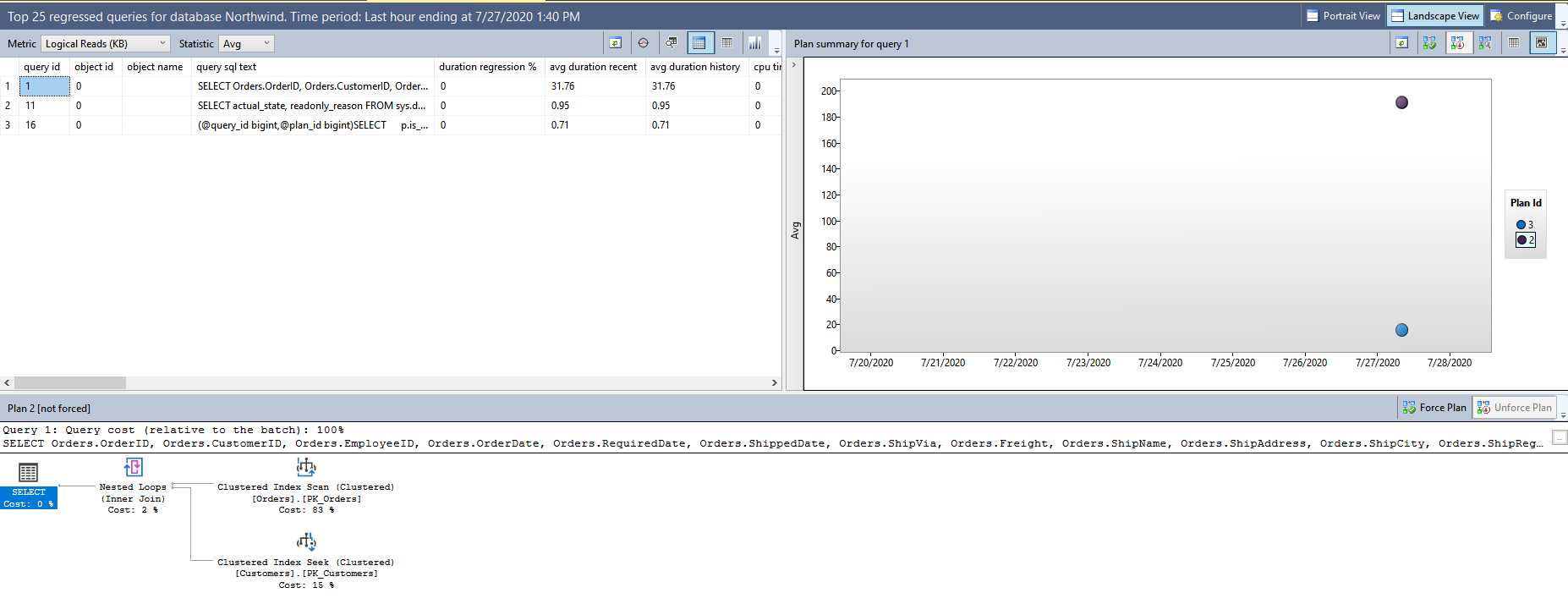
Image by @isaacmsmith
Query Store allows you to monitor and troubleshoot queries. It also provides stats about runtime such as CPU, IO and Memory.
Enable Query Store with default configuration using below SQL. It is enabled at database level.
ALTER DATABASE DatabaseName
SET QUERY_STORE = ON ( WAIT_STATS_CAPTURE_MODE = ON );
Query Store is enabled at database level. It can not be enabled on master & tempdb. It collects data in asynchronous way. Thus it does not affect query performance.
Once you run the above script. You should see a node under your database named 'Query Store'.
Query Store Interactive Reports
Query Store Views
Query Stores Options can be queries.
SELECT * FROM sys.database_query_store_options;
Use Case 01 - Detect Query Performance Regression
Suppose you deployed a new release to production. As load increases, you started receiving timeout alerts if you have it configured. Or customer(s) are complaining slowness in general or intermittent time out issues.
Without Query Store, you will need handy scripts ready to fetch query plan to make sense of why regression has been introduced. It is not gurannted that you will be able to find the bad query plan. As SQL Server does not store plan history.
With Query Store you can find different plans used by this query. Compare those plan & understand usage of resources.
Northwind database Example - Detect Regression
Create Northwind database - You can get the scripts with data from here Northwind Schema & Data
Enable Query Store by executing below
ALTER DATABASE Northwind
SET QUERY_STORE = ON ( WAIT_STATS_CAPTURE_MODE = ON );
Now we use the below query to cause regression.
SELECT Orders.OrderID, Orders.CustomerID, Orders.EmployeeID, Orders.OrderDate, Orders.RequiredDate,
Orders.ShippedDate, Orders.ShipVia, Orders.Freight, Orders.ShipName, Orders.ShipAddress, Orders.ShipCity,
Orders.ShipRegion, Orders.ShipPostalCode, Orders.ShipCountry,
Customers.CompanyName, Customers.Address, Customers.City, Customers.Region, Customers.PostalCode, Customers.Country
FROM Customers INNER JOIN Orders ON Customers.CustomerID = Orders.CustomerID
WHERE ShippedDate > GETDATE()
Since Orders table have non-clustered index on ShippedDate. Lets drop it by running below command.
DROP INDEX [ShippedDate] ON [dbo].[Orders]
GO
Now run the query 100 times by using below script.
SELECT Orders.OrderID, Orders.CustomerID, Orders.EmployeeID, Orders.OrderDate, Orders.RequiredDate,
Orders.ShippedDate, Orders.ShipVia, Orders.Freight, Orders.ShipName, Orders.ShipAddress, Orders.ShipCity,
Orders.ShipRegion, Orders.ShipPostalCode, Orders.ShipCountry,
Customers.CompanyName, Customers.Address, Customers.City, Customers.Region, Customers.PostalCode, Customers.Country
FROM Customers INNER JOIN Orders ON Customers.CustomerID = Orders.CustomerID
WHERE ShippedDate > GETDATE()
GO 100
Lets create the non-clustered index which we dropeed earlier. After creating index run the above query again.
CREATE NONCLUSTERED INDEX [ShippedDate] ON [dbo].[Orders]
(
[ShippedDate] ASC
)WITH (PAD_INDEX = OFF, STATISTICS_NORECOMPUTE = OFF, SORT_IN_TEMPDB = OFF, DROP_EXISTING = OFF, ONLINE = OFF, ALLOW_ROW_LOCKS = ON, ALLOW_PAGE_LOCKS = ON, OPTIMIZE_FOR_SEQUENTIAL_KEY = OFF) ON [PRIMARY]
GO
Now expan Query Store node under your database in SQL Server Studio. And click on Regressed Queries. You should be able to see report.
